The Biden administration just approved the Willow Project in Alaska’s National Petroleum Reserve.
Analysis by the Bureau of Land Management suggests this project will release annually the equivalent of 2 million gas powered cars.
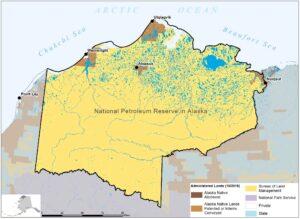
Map of the National Petroleum Reserve.
The 23 million acre reserve is the largest undeveloped and unprotected areas in the United States To give some perspective, the entire state of Maine is 20 million acres.
Development will likely include a minimum of 200 drill rigs, and miles of new roads, not to mention methane leaks, and yet another intrusion into the Alaskan wildlands.
The political decision the Biden Administration is weighing is how to foster good relations with Alaskan Senator Lisa Murkowski who has shown herself to be more independent than the average GOP senator. She voted, for instance, to impeach Trump.
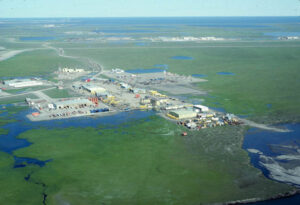
Oil development on North Slope of Alaska. Photo George Wuerthner
The other person the Biden Administration is attempting to placate is newly elected Mary Peltola who is half native and half white. Though Peltola is a Democrat, she is supportive of oil development in Alaska, in part, because many native groups also want the oil and other exploitation. Biden needs to help her get re elected to maintain the close division in the House.
Though most of the conservation media neglects to mention or only in passing suggests that Alaskan native people overwhelming support development of lands where they have a financial stake. In the case of the oil development on the North Slope, native groupsown the subsurface rights and earn royalties from oil development.
Plus, in many cases, native groups outside of the Arctic also support the Willow Project because they have oil field subsidiary companies that provide services, which in turn provides income for native people.
There also is “majority consensus” in support in the North Slope region, said Nagruk Harcharek, president of the group Voice of the Arctic Iñupiat, whose members include leaders from across much of that region. Supporters have called the project balanced and say communities would benefit from taxes generated by Willow to invest in infrastructure and provide public services.
While there is opposition to development within any group, including native people, the majority of people in Alaskan villages have limited economic opportunities, and mining, oil, logging, and other development projects are welcomed.
While the Biden Administration suggests that it will put limits on development of 13 million acres of the National Petroleum Reserve, as well as place the Beaufort Sea off limits to new oil drilling, the effect is a net loss of wilderness and wildlife habitat.
It’s important to recognize that every new development and its attendant air strips, roads, and work communities increases the chance for expansion.
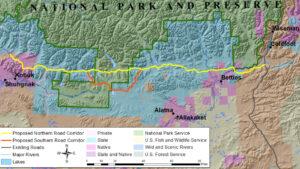
Map of proposed Ambler Road.
We see a similar expansion occurring with regards to the Ambler Mining District which lies just south of the Noatak Preserve along the Kobuk River. A 211 mile long road is proposed that would branch off the existing Dalton Highway (pipeline haul road) along the southern edge of the Brooks Range to carry equipment and ore to and from the mining site.
Again, both Mary Peltola and Lisa Murkowski support the mining venture as do many native people, including the Inuit folks in NW Alaska who own many of the mining claims at Ambler.
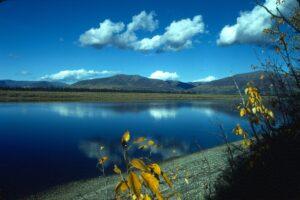
Kobuk River, Alaska. Photo Geoge Wuerthner
The Biden administration has yet to make a final decision on the Ambler Road, but given the support of both the Democratic and Republican Congressional delegation, I believe they will approve the road—of course, with the usual blather about strict guidelines to limit environmental impacts.
In yet another dangerous position, Secretary of Interior Haaland is supporting the decommission of wilderness at Izembek National Wildlife Refuge on the Alaskan Peninsula to facilitate construction of a road between the village of King Cove and Cold Bay. There is a large full scale air strip at Cold Bay that road advocates believe will increase the profitability of salmon fishing by making quick access to markets possible.
If Secretary Haaland can simply declassify wilderness than no place is safe.
The Izembek proposal may be an even biggest threat to Alaskan wildlands than the Willow Project and Ambler Road. If allowed to stand it would permit the Secretary of Interior (any Sec of Interior) to declassify wilderness and park protections for resource development. But thus far, Haaland is supporting the road development likely because it involves Aleut commercial interests.
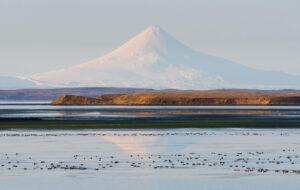
Izembek NWR on the Aleutian Peninsula.
When combined with other proposals such as a gold mine in Lake Clark National Park (also native owned), potential transfer of Tongass National Forest to native groups (who after previous land transfer logged the old growth), and other projects, Alaska’s wildlands may be under great threat of compromise and development under the Biden/Haaland administration than any previous time.
Meanwhile though the Biden Administration has reinstated the Roadless Rule on the Tongass, reestablished expanded boundaries for Bears Ears and Grand Staircase Escalante NMs, it has been slow to protect new national parks, wilderness, and national monuments.
There isn’t much time left for Biden to reach or even come close to his much vaulted 30 x 30 protection plan for setting aside 30 percent of the United States from resource development by 2030.